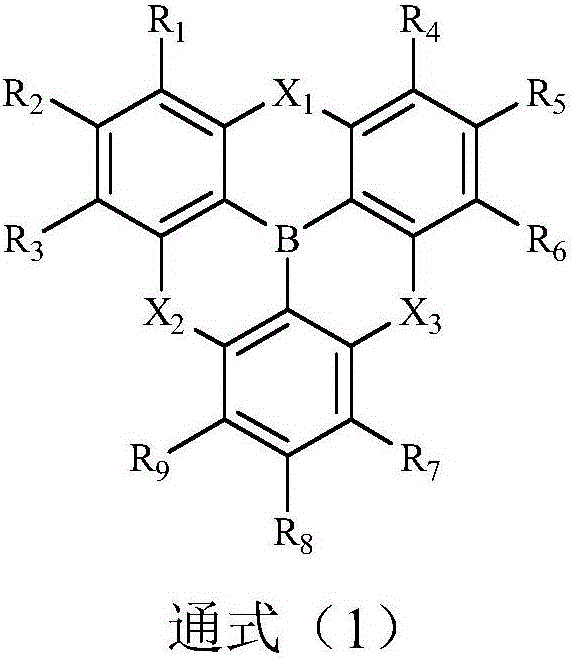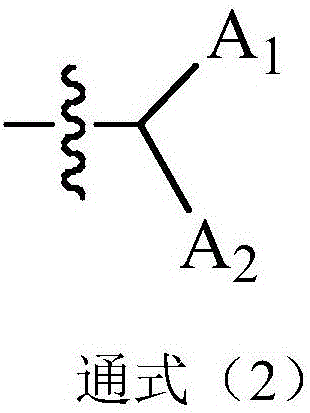Boron-containing organic electroluminescent compound and application to OLED device
A technology of electroluminescent devices and compounds, which is applied in the field of semiconductors, can solve the problems of low external quantum efficiency, large difference, and low internal quantum efficiency, and achieve the effects of improving device efficiency, color purity, and device life.
- Summary
- Abstract
- Description
- Claims
- Application Information
AI Technical Summary
Problems solved by technology
Method used
Image
Examples
Embodiment 1
[0054] Example 1 (Compound 01)
[0055]
[0056] The concrete synthetic route of this compound is provided now:
[0057]
[0058] 250ml four-necked bottle, under nitrogen protection, add 0.01mol intermediate A, 0.025mol phenylboronic acid, 0.05g pd (pph 3 ) 4 (tetraphenyltriphenylphosphine palladium), 60ml each of toluene, ethanol, and water, heated and refluxed for 20 hours, and the reaction was complete; naturally cooled, filtered, and the filtrate was rotary evaporated, and passed through a silica gel column, with toluene:ethanol=2:1 (volume ratio ) mixed solvent for beating, and a white solid was obtained after recrystallization, the purity (HPLC) was 97.8%, and the yield was 66.6%.
[0059] Elemental analysis structure (molecular formula C 39 h 35 B): theoretical value C, 91.04; H, 6.86; N, 2.10;
[0060] Test values: C, 90.92; H, 6.95; N, 2.13.
Embodiment 2
[0061] Example 2 (Compound 08)
[0062]
[0063] The concrete synthetic route of this compound is provided now:
[0064]
[0065] 250ml four-neck flask, under nitrogen protection, add 0.01mol intermediate A, 0.025mol dibenzofuran-4-boronic acid, 0.05g pd (pph 3 ) 4 (tetraphenyltriphenylphosphine palladium), 60ml each of toluene, ethanol, and water, heated and refluxed for 20 hours, and the reaction was complete; naturally cooled, filtered, and the filtrate was rotary evaporated, and passed through a silica gel column, with toluene:ethanol=2:1 (volume ratio ) mixed solvent for beating, and recrystallized to obtain a white solid with a purity (HPLC) of 98.3% and a yield of 64.6%.
[0066] Elemental analysis structure (molecular formula C 51 h 39 BO 2 ): theoretical value C, 88.18; H, 5.66; B, 1.56; O, 4.61
[0067] Test value: C, 88.25H, 5.53; B, 1.49; O, 4.73
Embodiment 3
[0068] Example 3 (compound 10)
[0069]
[0070] The concrete synthetic route of this compound is provided now:
[0071]
[0072] In a 250ml four-neck flask, under nitrogen protection, add 0.01mol of intermediate A, 0.025mol of bis(3,4-dimethylphenyl)amine, 0.03mol of sodium tert-butoxide, 1×10 -4 mol Pd 2 (dba) 3 , 1×10 -4 mol tri-tert-butylphosphine, 200ml toluene, heated to reflux for 20 hours, the reaction was complete; naturally cooled, filtered, the filtrate was rotary evaporated, passed through a silica gel column, beaten with a mixed solvent of toluene:ethanol=3:1 (volume ratio), and recrystallized A white solid was obtained with a purity (HPLC) of 97.6% and a yield of 64.5%.
[0073] Elemental analysis structure (molecular formula C 59 h 61 BN 2 ): theoretical value C, 87.60; H, 7.60; N, 3.46; B, 1.34
[0074] Test value: C, 87.54; H, 7.54; N, 3.61; B, 1.31
PUM
| Property | Measurement | Unit |
|---|---|---|
| thickness | aaaaa | aaaaa |
Abstract
Description
Claims
Application Information
 Login to View More
Login to View More - R&D
- Intellectual Property
- Life Sciences
- Materials
- Tech Scout
- Unparalleled Data Quality
- Higher Quality Content
- 60% Fewer Hallucinations
Browse by: Latest US Patents, China's latest patents, Technical Efficacy Thesaurus, Application Domain, Technology Topic, Popular Technical Reports.
© 2025 PatSnap. All rights reserved.Legal|Privacy policy|Modern Slavery Act Transparency Statement|Sitemap|About US| Contact US: help@patsnap.com



